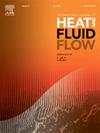分散在微通道中的自由颗粒对池沸传热影响的实验和数值模拟
IF 2.6
3区 工程技术
Q2 ENGINEERING, MECHANICAL
International Journal of Heat and Fluid Flow
Pub Date : 2024-10-07
DOI:10.1016/j.ijheatfluidflow.2024.109595
引用次数: 0
摘要
池沸腾是一种高效的热传递方法。本实验采用铜粉高温烧结法制备了带有微通道的多孔介质。研究重点是去离子水池沸腾过程中,分散在微通道内的不同比例的游离粒子对传热性能的影响。多孔介质中的微通道保持一致的宽度和深度。研究结果表明,临界热通量(CHF)和传热系数(HTC)均有所提高。值得注意的是,在微通道内分散了 20% 游离颗粒(FPPM-20%)的传热表面具有最显著的强化效果。与抛光铜表面相比,ΔT 降低了 5 °C,CHF 增加了 192 %,HTC 增加了 333 %。使用 ANSYS 模拟了具有相同结构的物理模型,结果与实验结果一致。本文章由计算机程序翻译,如有差异,请以英文原文为准。
Experimental and numerical simulation of the effect of free particles dispersed within microchannels on pool boiling heat transfer
Pool boiling represents an efficient method of heat transfer. In this experiment, porous media with microchannels are prepared using the high-temperature sintering method for copper powder. The investigation focuses on the impact of various proportions of free particles dispersed within the microchannels on the heat transfer performance during deionized water pool boiling. The microchannels within the porous media maintain consistent width and depth. The findings reveal enhancements in critical heat flux (CHF) and heat transfer coefficient (HTC). Notably, the heat transfer surface featuring 20 % free particles dispersed within the microchannels (FPPM-20 %) exhibits the most significant strengthening effect. This is evidenced by a reduction of ΔT by 5 °C, an increase in CHF by 192 %, and an increase in HTC by 333 % compared to the polished copper surface. The physical model with the same structure is simulated using ANSYS, yielding results consistent with the experimental findings.
求助全文
通过发布文献求助,成功后即可免费获取论文全文。
去求助
来源期刊

International Journal of Heat and Fluid Flow
工程技术-工程:机械
CiteScore
5.00
自引率
7.70%
发文量
131
审稿时长
33 days
期刊介绍:
The International Journal of Heat and Fluid Flow welcomes high-quality original contributions on experimental, computational, and physical aspects of convective heat transfer and fluid dynamics relevant to engineering or the environment, including multiphase and microscale flows.
Papers reporting the application of these disciplines to design and development, with emphasis on new technological fields, are also welcomed. Some of these new fields include microscale electronic and mechanical systems; medical and biological systems; and thermal and flow control in both the internal and external environment.
 求助内容:
求助内容: 应助结果提醒方式:
应助结果提醒方式:


